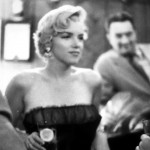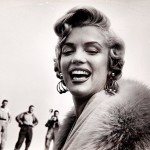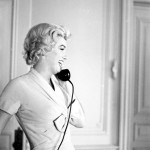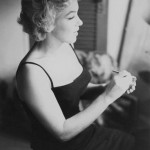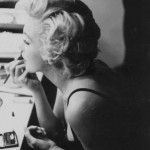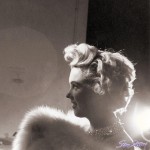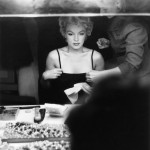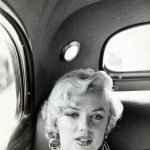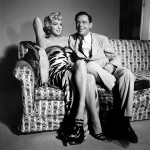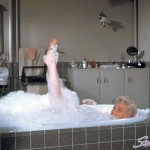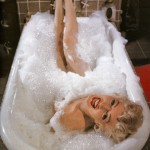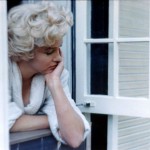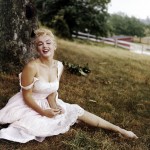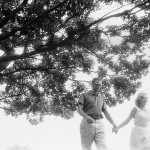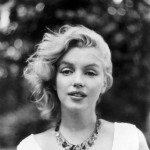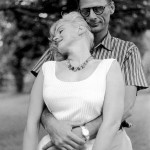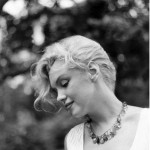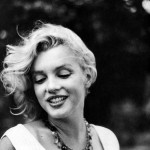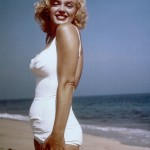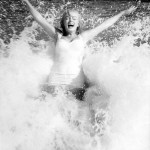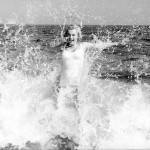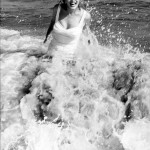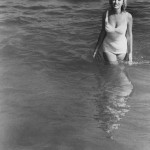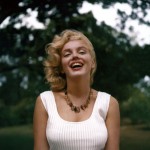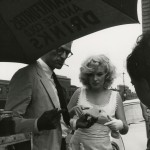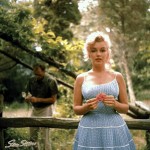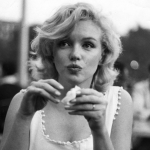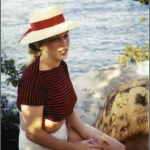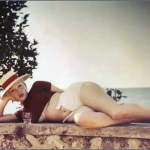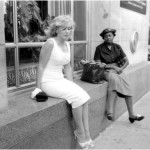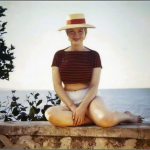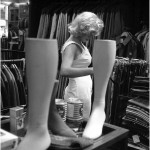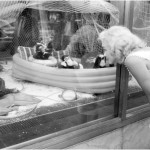1954
1957
In the early 1950s, Shaw’s talents took him to Hollywood where he began work as still photographer to the stars as well as special still photographer on several film sets. The studios would hire Sam to help show the stars’ best sides, to help further their careers and promote their films. His work was never about him; it was always about his subjects. And through his Hollywood work, he formed many lifelong friendships with the stars because they recognized his loyalty and they knew that they could trust him. Although ultimately most famous for his work with Marilyn Monroe between 1954 and 1957, the images of countless famous faces were captured by his lens, such as Humphrey Bogart, Alfred Hitchcock, Fred Astaire, Elizabeth Taylor, Sophia Loren, Marlon Brando, John Wayne, Audrey Hepburn, and others. What made his photographs unique was his preference for natural moments and poses rather than the more common studio glamour shots of the day. He carried the methods of the photojournalist with him to his Hollywood sessions, leading to unique and very real photographs. Even in the most artificial city in the world, Sam felt he was there to capture images that told a story about his subject, rather than to create something false. His work was much-admired, leading to his photos often gracing the covers of LIFE and Look magazine, two of the most popular and prestigious publications of the time, among others.
By the end of the 1950s, Shaw decided to take his work a step further artistically, and he began a new career as a film producer. Paris Blues (1961) starring Paul Newman and Sidney Poitier was his first production. He became a close collaborator with, as well as a close friend to, filmmaker John Cassavetes, producing several of his films in the 1970s, including Sam also continued to make use of his photographic skills on the set as special still photographer for his films, and worked on storyboards, as well as the publicity and advertising.He did not forget his past work and throughout the years, he enjoyed giving exhibitions of his photographs.Sam Shaw met Marilyn Monroe on the set of the film Viva Zapata! in 1951 when Sam worked as special still photographer on the film. Marilyn was not working at the time, but visited the set often as she was dating the film’s director Elia Kazan, and she would drive Sam to the set daily. In 1954, Shaw was hired as special still photographer for Billy Wilder’s film production of The Seven Year Itch which became one of Marilyn’s biggest and best-remembered films. While filming on location in New York City, Sam took some of the most famous shots of Marilyn as she stood over a subway grate, her skirt billowing in the air around her, ultimately creating the most iconic images of her career. Sam’s on-set photos were not only used for standard publicity for the movie, but they were also used in a 1955 paperback called Marilyn Monroe as The Girl which told the story of the making of Itch. In the summer of 1957, Sam took some of the very loveliest shots of Marilyn, in which she looked very much herself and hardly at all the internationally famous star that she was. A carefree girl dancing in her Connecticut garden, having quiet moments with her husband Arthur Miller and their dog Hugo, enjoying a long telephone conversation with a friend, taking a tour by car and by foot of Manhattan and Brooklyn, shopping in the men’s department for a tie for her husband, boating in Central Park, frolicking at a Long Island beach looking simultaneously like a giddy teen and a sizzling temptress. It was, once again, Sam’s unique style in capturing a moment rather than creating one which makes these photos so unique and striking. Although, he would be quick not to take too much credit if asked – he said that Marilyn knew the camera better than his other subjects. He never knew how she related so well to it and wondered if it was simply an instinct for her. He said that Marilyn had ‘magic’ and that came through his lens no matter how simplistic the shot may have otherwise been.
Marilyn became a dear friend to Sam and to his entire family, who all adored her. She would accompany them on family outings, never behaving untouchable. She was, instead, sweet and tender. To this day, Sam’s daughters Edie and Meta say they do not have enough nice words to say about Marilyn and she left them with many happy memories. Sam also served as a kind of mentor to Marilyn, who had an intense desire to learn about anything which interested her. Much of her interest lay in the arts, so Sam was certainly a great source of help and he happily encouraged her. He helped with her desire to read good books and he suggested that she begin to piece together her own art collection. Sam loved smart, strong women and he loved that side to Marilyn. Sam always saw Marilyn as basically a happy, joyful person. Although she did endure bad times, and he was witness to some of them, such as her 1957 miscarriage, Marilyn always got through them. Years after her passing, he specifically wanted to convey that to the public through two of his publications – 1979’s The Joy of Marilyn – In the Camera Eye and 1987’s Marilyn Among Friends on which he collaborated with mutual friend and poet Norman Rosten. He was protective of Marilyn in life and continued to protect her even after, in trying to make sure the public saw her as he saw his friend Marilyn – joyful, hard-working, and loving.
SAM ON MARILYN (from The Joy of Marilyn – In the Camera Eye, 1979):
“Marilyn wanted to be a professional beauty, and we had some wonderful discussions about that.”
“Marilyn had a tremendously sincere desire for the arts.” “She felt she wasn’t beautiful – wasn’t a natural beauty like Elizabeth Taylor.”
“One of her greatest ambitions was to appear in Vogue and Harper’s Bazaar. She wanted to be sleek and fashionable, as the high fashion models were.”
“Marilyn was Hollywood. She’s the most perfect example of Hollywood.”
“Marilyn found herself in the business of being a superstar. She became a business woman. … she laid the laws down. She became a tough, tough tomato. A tough tomato. She became a tyrant as a producer, a big tycoon trying to lay the law down to the Hollywood bigshots. And she nearly beat them.”
“She wanted the right to censor photographs. … As a professional, I respect that to a degree; she wanted to protect herself. I myself censor photographs I take which might hurt a star’s image. … I have one shot of Marilyn in The Seven Year Itch where director Billy Wilder is trying to pull some lines out of her. I’d never show that print.”
“In the long run, in the battle with the big studios, in the battle for life, she lost. …”
“She was a very knowledgeable film actress.” “She felt a terrific personal obligation to her public, her fans. She made herself into a superstar, but she felt that they had helped make her, too.”
“I think the major reason for her myth becoming larger and larger every day, for the legend growing on such a gigantic scale, is not the tragedy of her life. It’s the joy of the girl; she presented the joyous moment of a vibrant woman.”
“She represents the freedom which kids have today. Only, she was fifteen or twenty years ahead of the times, so she paid the price for her freedom.”
References: The Joy of Marilyn by Sam Shaw; Marilyn Among Friends By Norman Rosten & Sam Shaw; Biography.com; shawfamilyarchives.com; August 21, 2015 interview with Meta Shaw Stevens and Edith Shaw Marcus.[/vc_column_text][/vc_column][/vc_row][vc_row][vc_column width=”1/1″][vc_column_text]


